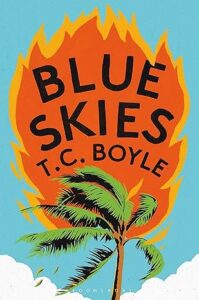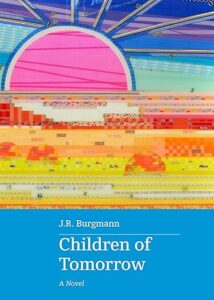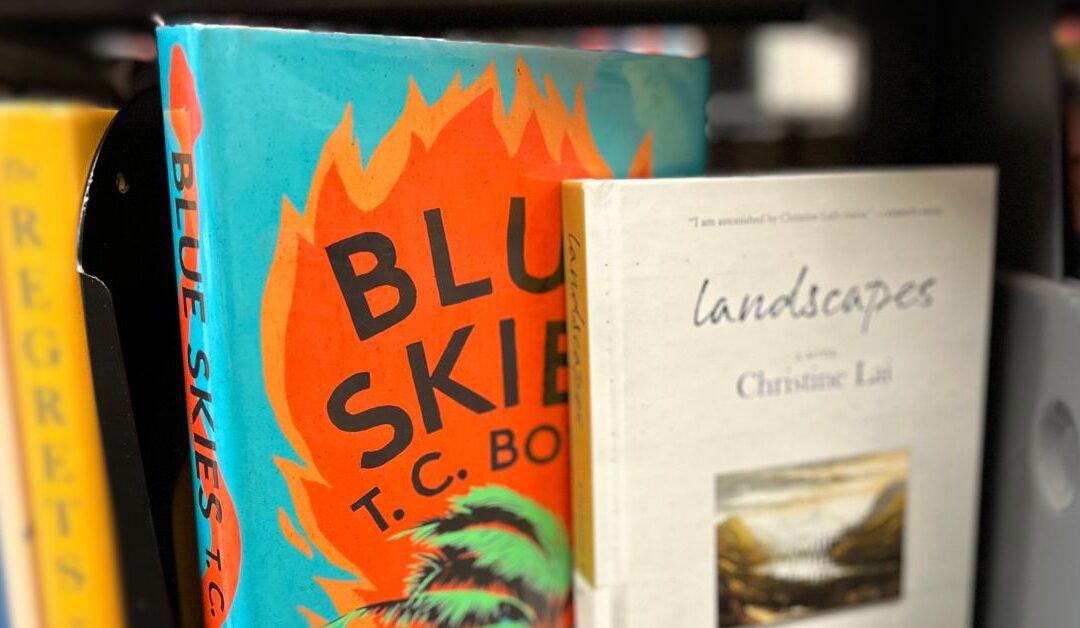Third in a Series: Brief Book Reviews
by Ross Thrasher
Is it frivolous to spend time reading novels during a climate emergency? I hope not, especially when fiction can offer insights into our predicament on a damaged planet. The GTEC Reader aspires to provide an arts and culture lens on climate change, and so we feature poetry, photography and creative prose in these pages.
As noted in the first of these sets of book reviews (in the December 2023 issue of the GTEC Reader), my personal preference is to seek out realistic fictional depictions of the environmental crisis. If you like to read novels about interplanetary travel, alien invasions or other way-out manifestations of science fiction, you won’t find them here. I don’t mind peering into the future, but not too far out. Give me a plausible human-interest story with The Great Unravelling as a backdrop. That’s what I’m trying to reflect upon in this series of reviews.
Landscapes by Christine Lai (Doubleday Canada, 2023)
 Vancouver author Christine Lai has written an atmospheric first novel, Landscapes, in which a dilapidated English mansion mirrors the degradation of nature after the climate collapse. The old house, Mornington Hall, contains a cornucopia of artworks and collectibles. Penelope, a resident art historian, narrates the story in the form of a diary, punctuated by archival descriptions of the books, paintings and ephemera that she is cataloguing. Many of these items are in poor condition, like the house and the large rural estate surrounding it. Climate change is the culprit. “It has been almost three years since it last rained in this part of England. First came the rains, then came the droughts.” There are holes in the roof. Termites have infested the walls. Most of the trees on the estate have died. Much of nearby London is flooded and uninhabitable.
Vancouver author Christine Lai has written an atmospheric first novel, Landscapes, in which a dilapidated English mansion mirrors the degradation of nature after the climate collapse. The old house, Mornington Hall, contains a cornucopia of artworks and collectibles. Penelope, a resident art historian, narrates the story in the form of a diary, punctuated by archival descriptions of the books, paintings and ephemera that she is cataloguing. Many of these items are in poor condition, like the house and the large rural estate surrounding it. Climate change is the culprit. “It has been almost three years since it last rained in this part of England. First came the rains, then came the droughts.” There are holes in the roof. Termites have infested the walls. Most of the trees on the estate have died. Much of nearby London is flooded and uninhabitable.
The diary entries in Landscapes meditate on art and artists, like J.M.W. Turner whose paintings of ruined buildings and maritime storms reinforce a mood of death and decomposition. Penelope is an insomniac, tormented by reveries of violence and violation, triggered by memories of her past and the artworks she has studied. She awaits with dread the return of Julian, the estranged brother of her husband Aidan, for reasons that are murky until later in this story.
However, the diary is not all doom and gloom. Aidan and Penelope have converted Mornington Hall into a hostel for climate refugees, which brings them into contact with a diverse clientele of interesting people. One is an artist painting Penelope’s portrait. Another is a fabric artisan whom Penelope helps with sewing a quilt. Meanwhile Aidan is building a mobile home for the couple as Mornington Hall is about to be demolished.
Towards the end of the novel, the focus shifts to a description of Julian’s travels on the Continent, visiting museums and other tourist attractions, reading Kafka and Rilke, listening to Mahler. He makes the telling observation that “the encounter with an artwork might be a life-changing experience”. But his erratic movements and his hallucinatory thoughts are those of a disordered mind.
The undercurrent of loss and dislocation that permeates Landscapes reflects the environmental tragedies that have taken over these characters’ lives. Can art help us to rescue meaning from our personal and planetary demons?
Blue Skies by T. C. Boyle (Liveright, 2023)
 Blue Skies is a bicoastal American family saga in the midst of a destabilizing climate. We get the story from three perspectives: mother Otillie and son Cooper in California, and daughter Catherine (known as Cat) in Florida. A major drought and megafires on the West Coast are contrasted with constant rain and frequent flooding in the Sunshine State.
Blue Skies is a bicoastal American family saga in the midst of a destabilizing climate. We get the story from three perspectives: mother Otillie and son Cooper in California, and daughter Catherine (known as Cat) in Florida. A major drought and megafires on the West Coast are contrasted with constant rain and frequent flooding in the Sunshine State.
The affluent lifestyle of Otillie and her physician husband is being sabotaged by extreme weather events. She is preparing insect-based foods as a protein substitute for meat. Cooper is an entomologist who, while studying the population collapse of the monarch butterfly, suffers a medical crisis from a tick bite.
On the East Coast, Cat and her self-absorbed partner Todd are living in a rundown beach house he inherited from his late mother. Cat is trying to become an Internet influencer. On a whim she buys a python as a pet, and uses it as a gimmick to capture more online attention.
There is something symbolic and slightly obscene about Todd’s job. He’s a brand ambassador for a liquor company, which involves hosting drinking parties all over the world, imbibing while the world burns and floods. Alcohol is a big part of his and Cat’s home life too, and their excessive booze consumption has tragic consequences.
Blue Skies skewers contemporary trends like the illegal trade in endangered species, the refusal to move away from high-risk locations, and the quixotic effort to geo-engineer the climate. The title is ironic, but there is a metaphorical ray of sunshine at the conclusion of this cautionary tale.
The near-future of Blue Skies is a departure from most of Boyle’s oeuvre. I’m a big fan of his earlier novels, which explore various facets of the 20th-century American zeitgeist. He has authored quasi-biographies of real personalities like the architect Frank Lloyd Wright (The Women), sex researcher Alfred Kinsey (The Inner Circle), and cereal mogul John Harvey Kellogg (The Road to Wellville). Boyle’s other historical subjects have included a hippie commune in Alaska (Drop City), homeless Mexican immigrants (The Tortilla Curtain), and the Biosphere experiment (The Terranauts). Climate issues propel the plot in the latter three novels. It’s all good stuff.
Children of Tomorrow by J. R. Burgmann (Enfield & Wizenty, 2023)
 “Make Earth Great Again” reads one of the placards at a student climate strike, sometime in the mid-21st century in Melbourne, Australia. This scene appears in the middle section of Children of Tomorrow, the haunting debut novel of Aussie author J.R. Burgmann. Global warming is well advanced: Melbourne is about to experience its first-ever 50-degree Celsius day. One of the protesting school kids is Jasmine, the daughter of climate researchers Arne and Evie.
“Make Earth Great Again” reads one of the placards at a student climate strike, sometime in the mid-21st century in Melbourne, Australia. This scene appears in the middle section of Children of Tomorrow, the haunting debut novel of Aussie author J.R. Burgmann. Global warming is well advanced: Melbourne is about to experience its first-ever 50-degree Celsius day. One of the protesting school kids is Jasmine, the daughter of climate researchers Arne and Evie.
Each of the chapters in this chronological account is headed by a measurement of atmospheric CO2, from 400 ppm in the 2010s to 600+ ppm as the characters age. The early chapters relate Arne’s exposure to burning, shrinking forests in Tasmania while Evie, a free-diver, witnesses the slow death of the Great Barrier Reef. They share a bohemian lifestyle, travelling around the world separately as grad students and later as freelance researchers. “Extreme sea-level rise was locked in by the 2030s, the oceans thermally expanding with each fraction of a degree.” Eventually they settle in flooded London, England and start a family together.
Evie’s cousin Wally and Arne’s brother Freddie wander in and out of this episodic story over several decades. They are both eco-warriors too: Wally is an environmental writer and Freddie is a radical, involved in subversive efforts to save the planet. Although they all share similar perspectives, these family members are estranged, only rarely connecting online and even less often in person. Their reunions crackle with strong emotions — regret, anger, bereavement for a collapsing biosphere. “There was once a common misconception that a life of observation might steel a person for the planet’s unravelling; overwhelmingly, the opposite is turning out to be true.”
The next generation, Jasmine and her brother Raphael, go in opposite directions. Jazz follows the activist path carved out by her parents and “Mother Greta”, while Raph becomes a businessman and a social-media troll.
Children of Tomorrow is a powerful story that reads at times like a prose poem. At the beginning: “Green goes longer than flesh, rocks longer than trees, stars longer than rocks — all within the cradle of the universe”. At the end: “In the afterburn of the world there is a great rewilding. Deviants scatter out over the planet into dusty cells, ploughing on towards the great green dream.” Burgmann has conjured a keeper here.
Fire in the Canyon, by Daniel Gumbiner (Astra House, 2023)
 Wildfires in California’s wine country animate Daniel Gumbiner’s engaging new novel, Fire in the Canyon. Ben owns a small farm that is mainly devoted to growing wine grapes. His wife Ada is a successful novelist who suffers writer’s block after losing an unfinished manuscript during a fire evacuation early in the story. Their son Yoel, who has had a strained relationship with his father, visits from L.A. and ends up staying all summer to help on the farm.
Wildfires in California’s wine country animate Daniel Gumbiner’s engaging new novel, Fire in the Canyon. Ben owns a small farm that is mainly devoted to growing wine grapes. His wife Ada is a successful novelist who suffers writer’s block after losing an unfinished manuscript during a fire evacuation early in the story. Their son Yoel, who has had a strained relationship with his father, visits from L.A. and ends up staying all summer to help on the farm.
Interesting lore about grape-growing, harvesting and wine-making comprises the centrepiece of Fire in the Canyon. It’s a community effort in a small-town setting, as Ben’s family enjoys a network of friends and neighbours who collaborate and celebrate the rhythms of the seasons together. Gumbiner has populated his narrative with a colourful supporting cast. But the heat, the wind and drought are harbingers of danger.
Further complications ensue as Yoel gets involved with a group of climate activists who are exposing the connection between fossil fuels and the changing environmental conditions that threaten the region.
Fire in the Canyon is first and foremost a well-told tale about ordinary, likeable people under duress from the stresses of a warming planet. Highly recommended.
Ross Thrasher enjoyed a career as a librarian at post-secondary institutions in the U.S., the South Pacific and Canada. Ross is interested in literature, travel and the performing arts. Read his two previous cli-fi book review compilations in the December 2023 issue and the March 2024 issue of the GTEC Reader.
If non-fiction appeals to you more, read Ross’s review on four new books with climate optimism as the main theme in the GTEC Blog.

